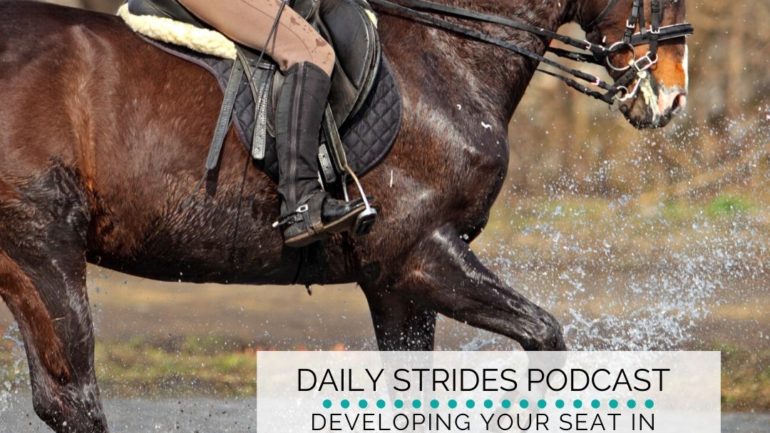The canter can be confusing for many riders. Especially what to do with your seat in the canter. You’re told to ride the horse forward with your seat. But you’re then told to be ‘quiet’ with your seat… So which is it? And how can you begin to develop a more effective seat in the canter?
It all begins with knowing where you are right now. I feel that there are a few things that decide your success in canter with your horse. How much digging you’re doing is one of them. And how much shoulder action is happening is another.
1. Start with Carrying Yourself
I want you to think about a clothes hanger with a dress or something long hanging on it. When the wind blows, the dress is moved by the wind, however, the hanger ensures that the dress doesn’t blow away.
Now, imagine your shoulders are like a clothes hanger. Your body is the garment hanging on the hanger. And your horse is the wind. The wind should be able to move the garment; your horse should be able to move your seat.
Your horse’s movement will move your seat, but because you are carrying yourself, you won’t be ‘blown away’ by the horse. When you carry yourself, it requires you to use your core strength in order to maintain your own balance. This allows your horse to do what you have asked; canter.
I think that canter is the gait that separates ‘fit’ riders from ‘unfit’ riders. It is definitely more difficult to fake strength and suppleness in the canter, hence a lot of riders having trouble with their seat to begin with in the gait. In order to really begin developing your seat, you need to first take responsibility for carrying your own body.
Think about creating space between the bottom of your ribcage and the top of your hips. Carrying your upper body allows your lower body to move with your horse. It allows the ‘wind’ to ‘move the garment’…
2. Allow Your Horse To ‘Lead You’ in the Canter
The basics are something we should revisit over and over again in our riding. And yet, so many riders have resistance to this.
The canter is a great place to get back to the basics in order to actually move forward and create momentum in your progress.
Following and allowing are things I speak a lot about when working with riders. In order to really begin developing your seat in the canter, you need to first be able to ‘follow’ your horse. This simply means being supple enough through your body to have your horse ‘move’ it. As your horse moves your body, or more specifically your seat, will then follow him. Not shove him or push him, but simply follow his movement.
Start in the walk. Slip your feet out of your stirrups and allow your horse to move your seat as you walk along. Notice how ‘carrying yourself’ is essential for this to happen.
From here, you can begin doing the same in the trot. Again, without the stirrups. Before building up to the canter. Notice how you are not shoving, pushing, forcing, digging in or anything else. You are simply following your horse’s movement. You are letting the horse move your seat.
3. Begin Refining Your Seat
Once you can follow, you can then begin to look at having more influence using your seat in the saddle. I recommend starting with the half halt. A huge part of the half-halt is ‘allowing’. This is often overlooked or forgotten by so many riders.
You ask the question, using the half halt and then you ‘allow’ your horse to answer, in this case through your seat.
You will probably find that you need to ask quite a few times initially in order to get a response. However, it is important to give your horse the space to respond each time. Ask and allow. Then repeat. Until you get the desired result.
Yes, you may have to ask differently if your horse is not understanding or hearing the question. However, once you have found the ‘point’ where he hears you, this is where you can really now begin to shift your focus.
Developing Your Seat in the Canter
Think back to when you first began riding. I can bet that your aids then look a lot different to your aids now. When you begin using your seat initially in the canter, it will also be a little different from what you actually want it to be months and years from now.
However, there has to be a ‘beginning point’. A place where you can start. And, once you have learned to follow with your seat, this is where I suggest you can begin focusing your attention on developing your seat in the canter.
It is also important to remember what goes on ‘under’ your seat. Your horse’s back is the connection between the back end and the front end of his body. If you find yourself at any point struggling with forwardness or contact, I would suggest turning your attention back to ‘carrying yourself’ and following. This will almost always allow the energy to flow through.
Canter is a wonderful gait. It does not have to be difficult or hard. And often, it only requires a willingness to ‘go backward’ a little in order to then leap forwards.
Happy Riding
Lorna
Additional Resources to Help with This Topic
-
-
-
- 3 Steps to Better Canter Transitions
- 3 Ways You Are Ruining Your Transitions from Trot to Canter
- Asking for the Correct Canter Lead when on the Straight
- Straightness in the Canter
- Using Your Body to Effectively Influence the Canter
- The Returning to Riding Program – Getting the Basics on Autopilot in Your Riding
- Equestrian Fitness Challenge
- Subscribe to the Daily Strides Podcast
- Join the free Strides for Success Online Community
-
-

